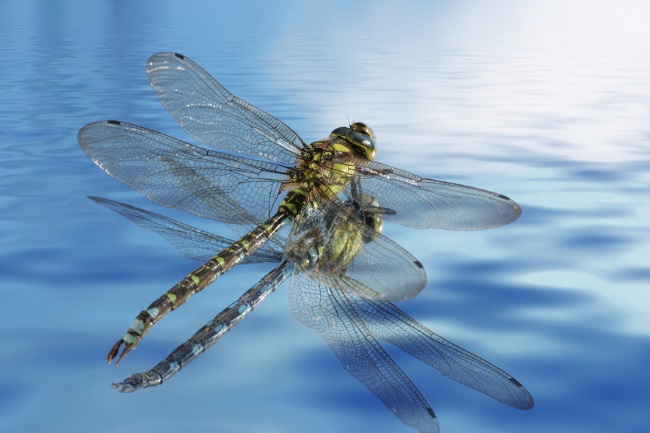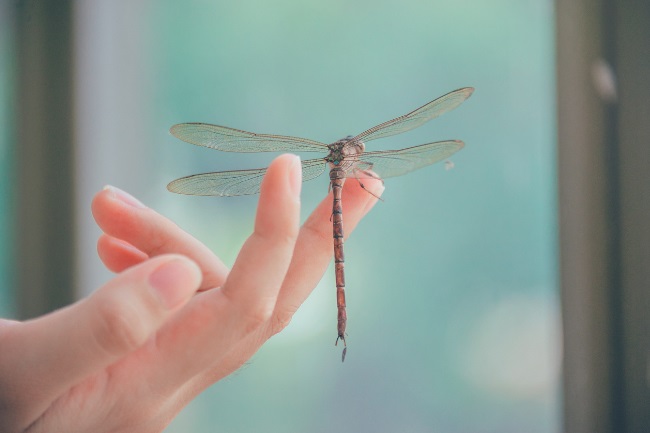Dragonflies are not dangerous to humans, though they are voracious predators, highly adapted to catch small insects. Their time is spent zipping through the air or swimming through water, with little interest in humans.
Contents
Terrifying insects

A fear of insects is very common. For some people, this can be because they move in an unfamiliar way or fly quickly towards them, in a startling manner. However, one common reason people are afraid of insects is that they rarely interact with them.
Living in urban environments, in places where the insect population has been decimated due to loss of habitat and use of pesticides, many people do not come into regular contact with wide varieties of insect species.
With all species being unfamiliar, the instinct arises to label them all as potentially harmful. In general, the assumption is that all insects will be able to bite or sting humans, and may be poisonous. While these defence mechanisms are common within the insect world, most are designed to put off much smaller adversaries.
For example, though most spiders are venomous, the venom isn’t strong enough to be harmful to humans for the vast majority of species and can’t even be administered as the spider’s fangs are too small and weak to break through human skin.
In reality most insects are fascinating creatures, too busy with their own lives to care about our presence. Though they may sometimes inconvenience us they also play a vital role in our world, such as earthworms creating the soil we grow our crops in, hoverflies pollinating our flowers and fly larvae helping dispose of rotting carasses, preventing the spread of disease.
Also read: How Long Does a Dragonfly Live for? (Lifecycle Explained)
What is a dragonfly?

There are over 3,000 species of dragonfly globally, and they are found on every continent apart from Antartica. They are flying insects that start life as aquatic larvae. Dragonflies can be differentiated from the closely related damselflies by the fact they hold their wings out perpendicular to their body when resting, whereas most damselfly species fold them parallel to their bodies.
With a long thin body, large eyes and two sets of mostly translucent wings, the blueprint for a dragonfly hasn’t altered much in millions of years. Dragonfly fossils found from the Carboniferous period are often much larger, but still highly recognisable as a modern dragonfly.
The reason dragonflies have altered so little is that they are so perfectly adapted to their lifestyle and their role as predators. When living under the water as larvae they are ambush hunters, their extendable jaws reaching out and snapping at midge larvae and other aquatic invertebrates. Having emerged into adulthood, they use their strong wings and excellent eyesight to zip through the air, grabbing small flying insects and often gobbling them up on the wing.
Few animals can catch a fully grown dragonfly once it’s in its element, though fast-flying birds like the hobby specialise in these nutritious insects. Most species will spend most of their time as adults searching for food or defending a mating territory.
Though they spend a lot of time near water during the mating time, they also go far away from pools and watercourses, feeling in fields and woodlands, even passing up and down roads catching insects.
Are dragonflies dangerous to humans?

Dragonflies do not use humans for food. In the end, we are much too large for them, with even the biggest dragonfly in the world, Australia’s giant petaltail, being only around 6cm (2.36in) long, with a 16cm (6.29in) wingspan.
However, insects don’t need to be big to harm humans; they can do so through their bites, stings and venoms. The good news with dragonflies is they lack two of these mechanisms.
Dragonflies do not possess stingers. However, many people mistakenly think they do due to the pointed appendages on the end of the dragonflies abdomen. In the male, these are cerci, claspers that he uses to grasp the back of the female’s neck as they are mating. The female also has a pointed ovipositor that she uses to lay her eggs.
| Risk | Description |
|---|---|
| Biting | Dragonflies are generally harmless and do not pose a significant biting risk to humans. They have short, weak mouthparts that are not designed for biting or piercing human skin. |
| Aggression | Dragonflies are not aggressive towards humans and rarely exhibit aggressive behaviors. They typically fly away when approached by humans. |
| Disease Transmission | Dragonflies do not transmit diseases to humans. They are not known to carry or spread pathogens that can cause illnesses. |
| Allergies | In rare cases, individuals with severe insect allergies may experience an allergic reaction if they come into direct contact with a dragonfly. However, such instances are extremely uncommon. |
Dragonflies are also not venomous. The main reason for this is that they don’t really need it. They are such fast and agile hunters that the addition of venom would be of no benefit. As soon as they grasp their prey, they begin to chomp it. As adults they aren’t ambush hunters, instead simply chasing down their victims with superior speed.
The one thing a dragonfly can do is bite. This is because they have large, powerful jaws they use for consuming their prey; both as larvae and adults. The good news, however, is that dragonflies are not interested in chomping on you.
The main reason insects bite humans is if they feel threatened or consume blood as a source of food. Dragonflies do not eat our blood, so the only other reason for them to bite is if they are threatened.
Yet, as these impressive fliers spend little time on the ground where we might accidentally step on them, it is highly unlikely a dragonfly will feel the need to defend itself from you unless you purposefully catch one.
Even if you do go out of your way to man-handle a dragonfly, most of the time their jaws are too small to make a real impact. Some of the larger species may have a more impactful bite, but the large majority of species won’t even attempt to bite you if handled, perhaps aware it wouldn’t do them any good.
It’s worth noting that dragonflies can be quite inquisitive and may fly close to humans to check out what we are. They may also fly around humans due to the other insects we attract, picking off flies attracted to our tasty picnics or mosquitoes called in for a more gruesome meal.
Though these close up encounters may appear aggressive, they are perfectly benign and actually help us by getting rid of other pesky insects.
Also read: How Many Legs Does a Dragonfly Have? Why Do They Need Them?
Are dragonflies dangerous to dogs or cats?

Many cats and dogs react strongly to the presence of large insects. Either they will be intrigued and want to catch the insect, or they will be afraid. While dragonflies cannot harm your pet and are often too fast for them to catch them, it’s important to prevent your pets from hurting wildlife.
| Risk | Description |
|---|---|
| Swallowing | Dogs and cats may try to catch and swallow dragonflies, which can lead to choking hazards. It is important to supervise pets when they are around dragonflies or other small flying insects. |
| Stings | Dragonflies do not possess stingers and are incapable of stinging. Therefore, the risk of a dragonfly sting to dogs or cats is negligible. |
| Allergies | Some dogs and cats may be allergic to insect bites or stings, including those from dragonflies. If a pet shows signs of an allergic reaction, such as swelling or difficulty breathing, seek veterinary attention immediately. |
| Eye Injuries | In rare cases, pets may experience eye injuries if they try to catch or play with dragonflies. Sharp wings or other body parts of the dragonfly can accidentally cause scratches or corneal abrasions. |
Particularly at dawn or dusk, dragonflies may be slow-moving and easy to catch. If you see your pet stalking or showing interest in easy to reach dragonflies, encourage them to move away and leave it be.
Do we need dragonflies?
Dragonflies are not only beautiful and fascinating creatures, but they also provide us with a great deal of benefits. Due to their abilities as hunters, they eat many of the insects that can, in large numbers, cause us serious problems.
Both as larvae and adults, they eat mosquitos, flies and other pest species. So next time you’re sitting beside a pond enjoying the sunshine, you’ve got plenty of time to be thankful for the dragonflies, for all the annoying bites they’ve saved you from.

